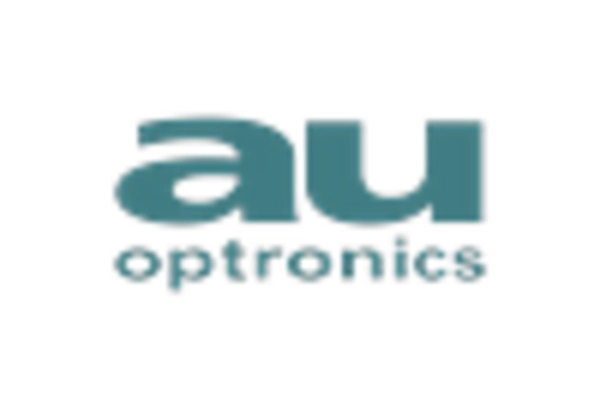Growth in Automotive Display Applications
The growth in automotive display applications is emerging as a significant driver for the Thin Film Transistor Market. As vehicles become more technologically advanced, the demand for high-quality displays in dashboards, infotainment systems, and heads-up displays is rising. Thin film transistors are essential for providing the clarity and responsiveness required in these applications. The automotive sector is projected to witness a compound annual growth rate of around 8% in the coming years, which will likely enhance the demand for thin film transistors. This trend indicates a promising avenue for growth within the Thin Film Transistor Market, as manufacturers adapt to the evolving needs of the automotive market.
Increasing Adoption of Wearable Technology
The increasing adoption of wearable technology is driving growth in the Thin Film Transistor Market. Wearable devices, such as smartwatches and fitness trackers, require compact and efficient display solutions. Thin film transistors are well-suited for these applications due to their lightweight and flexible nature. As the wearable technology market continues to expand, with projections indicating a growth rate of approximately 20% annually, the demand for thin film transistors is expected to rise correspondingly. This trend presents a unique opportunity for manufacturers in the Thin Film Transistor Market to develop innovative solutions tailored to the specific needs of wearable technology.
Rising Demand for Energy-Efficient Displays
The Thin Film Transistor Market is experiencing a notable surge in demand for energy-efficient display technologies. As consumers and businesses alike become increasingly conscious of energy consumption, the need for displays that consume less power is paramount. Thin film transistors, known for their low power requirements, are becoming the preferred choice in various applications, including smartphones, tablets, and televisions. According to recent data, the market for energy-efficient displays is projected to grow at a compound annual growth rate of approximately 10% over the next five years. This trend indicates a robust opportunity for manufacturers within the Thin Film Transistor Market to innovate and cater to the evolving preferences of environmentally conscious consumers.
Expansion of the Consumer Electronics Sector
The expansion of the consumer electronics sector is a key driver for the Thin Film Transistor Market. With the proliferation of smart devices, including smartphones, tablets, and smart TVs, the demand for high-quality displays is escalating. Thin film transistors play a crucial role in enhancing display performance, providing better color accuracy and resolution. Recent statistics suggest that the consumer electronics market is expected to reach a valuation of over 1 trillion dollars by 2026, which will likely bolster the Thin Film Transistor Market. This growth presents opportunities for manufacturers to innovate and develop new products that meet the increasing consumer expectations for superior display technology.
Technological Advancements in Semiconductor Materials
Technological advancements in semiconductor materials are significantly influencing the Thin Film Transistor Market. Innovations in materials such as organic semiconductors and oxide semiconductors are enhancing the performance and efficiency of thin film transistors. These advancements allow for improved electrical characteristics, leading to better display quality and faster response times. The market is witnessing a shift towards flexible and lightweight displays, which are made possible by these new materials. As a result, the Thin Film Transistor Market is poised for growth, with projections indicating a potential increase in market size by 15% over the next few years, driven by the adoption of these advanced materials.

















Leave a Comment